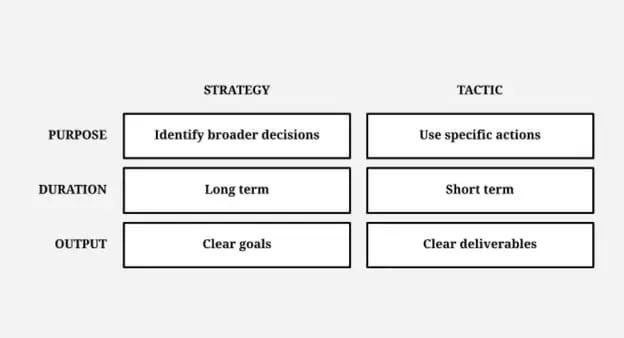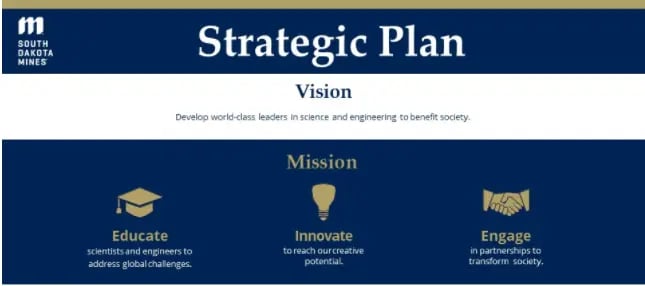Whether you've set personal or business goals, you likely created a plan to achieve them. Without clearly defined steps, it can be difficult or even discouraging to tackle the goal you've set.

One example of a situation where planning and strategy come in handy is during a job search. Let's say you've spent weeks or months scouring the internet for a new sales job, but none of the job postings seem to match your skill set or career interests.
Have you taken a step back and thought about a specific type of sales job you want? And did you consider the most important qualities you're looking for in an employer or career?
Your online job search will become less tedious and disheartening if you have a clear set of objectives to follow. While you might get more search results for "sales manager", you'll find jobs that are a better fit for you if you clarify by searching for "senior sales manager - medical devices."
With your new search strategy, you've identified a seniority level and the industry you'd like to work in. The next steps you set for yourself are to periodically repeat this search and only apply to the roles that seem like the best fit for you and your career aspirations.
Thinking strategically helps you narrow down your search and use your time more effectively. Plus, you'll increase the likelihood of landing a job that's a great fit for you.
Once you aced your interviews and landed the perfect sales job, you'll find that these types of planning, strategic and tactical, are used by many businesses and sales teams to set themselves up for success.
.png)
Free Strategic Planning Template
Access a business strategic planning template to grow your business.
- Sales and Revenue Growth
- Growth of Customer Base
- Expansion into New Regions
- And more!
Strategic vs. Tactical Planning
Strategic planning lays out the long-term, broad goals that a business or individual wants to achieve. And tactical planning outlines the short-term steps and actions that should be taken to achieve the goals described in the strategic plan.
Your strategic plan provides the general idea of how to reach a goal, and the tactical plan is where you lay out the steps to achieve that goal.
Since the objectives set in the strategic plan are more general and are evaluated over a longer period of time, strategic planning typically occurs at the beginning of a year, quarter, or month. These plans should be reviewed every quarter.
Tactical planning occurs after the strategic plan is outlined, and the tactical plan can be reexamined on a more frequent basis — if need be.

Free Strategic Planning Template
Fill out the form to document your planning process.
Here are some high-level examples that touch on the difference between the two types of planning.
Strategy vs. Tactics
Let's consider the perspective of a hypothetical company analyzing different strategies to improve different aspects of its sales operations.
1. Sales Recruitment
- Strategy — We want to develop repeatable evaluation criteria for hiring the right salespeople.
- Tactics — We will narrow down the specific qualities the company wants out of its salespeople, draft appropriate interview questions to shed light on those qualities, and train recruiters to conduct interviews based on those key tenets.
2. Smarketing
- Strategy — We want to improve sales and marketing alignment.
- Tactics — We will clearly define the qualities of an SQL so that marketing can fous their efforts on those, encourage collaboration between departments on the creation of sales content, and hold interdepartmental retrospectives after each marketing campaign.
3. Technological Infrastructure
- Strategy — We want to build a more sound, technological foundation for our sales operations.
- Tactics — We will adopt a CRM, incorporate a conversational intelligence tool for improving sales calls, and make virtual sales enablement resources available to our reps.
Taken together, the strategies and tactics a sales organization employs — like the ones listed above — comprise what are known as sales plans.
Sales Plans
A sales plan encompasses both strategic and tactical planning and contributes to an organization's overarching sales strategy. It outlines the broad goals your sales team and reps should strive for, and it creates an action plan to reach them.
The strategic plan sheds light on the mission, objectives, and future goals of the organization or individual. Managers, VPs, and executives typically create strategic plans for an organization, but this type of plan can also be used by individuals to achieve personal or professional goals.
These are the key components to include in a strategic plan:
- Mission and background of the business or situation: Where do you currently stand? And where do you want to be in the future?
- Goals and objectives: What would you like to achieve?
- DRIs (directly responsible individuals): Who are the people responsible for these goals?
Strategic planning and tactical planning provide guidelines for businesses, teams, and individuals to follow. And the tactical plan outlines exactly how they'll achieve the final result.
Strategic Goals vs. Tactical Goals
A major part of planning, whether it’s strategic or tactical, is setting goals. You should actually set goals for both your strategic planning and your tactical planning. Having those objectives clearly laid out helps push your plans into direct action. Your strategic goals should be broader while your tactical ones should be more specific.
For example, a strategic goal may be to develop a company culture that encourages growth and retention. A tactical goal may be to survey all existing employees to gain information on why they weren’t retained. If your tactical planning and your strategic planning are related, then the goals for each should also have a connection between them.
.png)
Free Strategic Planning Template
Access a business strategic planning template to grow your business.
- Sales and Revenue Growth
- Growth of Customer Base
- Expansion into New Regions
- And more!
Strategic Planning
A strategy is defined by Merriam-Webster as “a careful plan or method for achieving a particular goal usually over a long period of time.” So, strategic planning is meant to achieve something for the bigger picture.
Tactical planning includes the immediate actions that feed into the larger purpose outlined by a strategy. These plans are carried out in the long term and incorporate big, impactful changes. There are nine strategic planning models your business can use as a starting point.

Strategic Planning Examples

Since tactical planning is more direct, it’s often more specific to your team or business. Strategic plans, however, are often broad enough to be applied to a whole niche or industry. For instance, strategic planning for sales could involve some similar goals across different companies, but their tactical plans may be unique. Here are a few examples of strategic plans that could apply to different businesses.
- Acquire 50% more clients by the end of the year.
- Improve SEO rankings by 20%.
- Expand the customer service team where satisfaction is lacking.
Tactical Planning
Tactical planning occurs after a business, team, or individual has created a strategic plan that outlines general goals and objectives. A tactical plan describes the steps and actions that must be taken to achieve the goals from the strategic plan.
Once you've created your strategic plan, it's time to determine the tactics you'll use to reach your goals. This is where the tactical plan comes into play.
It's used to outline the steps a business or individual will need to take to accomplish the priorities that have been set. Here are a few things to consider when developing your tactical plan:
- What is the timeline for achieving these goals?
- Are there tools or resources that are necessary to accomplish these objectives?
- What specific actions should be taken to achieve the intended outcome?
Your tactical plan will provide the answers to these questions to help you meet the objectives of the strategic plan.
So, what do strategic and tactical planning look like in practice?
Tactical Planning Examples
While strategic and tactical plans can vary by company or industry, there are some that can apply to many sales organizations and teams.
Here are a few examples that are common for sales teams and reps. The strategic plans are numbered, and the tactical plans are outlined below.
1. Fill my pipeline with more leads over the next two weeks.
- Spend an hour prospecting each day.
- Leverage social selling, and join five LinkedIn Groups that your prospects belong to.
- Attend an industry networking event.
2. Close more enterprise deals each month.
- Enroll reps in a hands-on training session in your Enterprise product offerings.
- Set a goal for each rep to schedule at least three demos with enterprise-level prospects this quarter.
- Create an incentive for those that close the most Enterprise deals in the month.
3. Hire 20 more entry-level sales representatives by the end of Q1.
- Create a hiring profile that candidates should meet.
- Develop a LinkedIn outreach campaign to find and attract new talent.
- Attend career fairs at 15 local universities.
Your Business Needs Both Strategic and Tactical Planning
There is a purpose to both strategic and tactical planning. Each moves your business’ progress closer to larger goals and objectives. With a solid strategic plan and a detailed tactical plan, you'll be well-equipped to grow your business.
Editor's note: This post was originally published on February 28, 2019, and has been updated for comprehensiveness.






![How to Develop a Strategic Plan for Business Development [Free Template]](https://blog.hubspot.com/hubfs/Copy%20of%20Featured%20Image%20Template%20Backgrounds-2.png)




